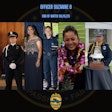You don't need to have majored in biology to know that men and women are not created equal—in measurements, that is. That's why female officers need ballistic vests made especially for their unique shapes. And now that women make up a more significant amount of the market share in law enforcement, body armor companies are taking notice.
That's not to say that companies have never created vests for women. Long gone are the days when women were relegated to desk jobs wearing long blue skirts and called "matrons." But only now are vest manufacturers making a concerted effort to market to this growing demographic of the thin blue line.
The Numbers Game
"Women make up 15 percent of law enforcement now, according to uniform shirt manufacturers," says Georg Olsen of US Armor. "And the number is climbing in metro areas, including New Jersey, Florida, and Pennsylvania."
Other markets are waking up to women's buying power, too.
"If you look at the athletic industry and other industries, you'll see that customized products for women are definitely on the rise," says Jill Duggan of PACA Body Armor. "And that's because women are definitely a populace to contend with."
What this means for women is more choice and more of a voice in the industry, especially with an increasing number of women filling executive roles such as captain and chief.
"Yes, there is a trend, and body armor manufacturers would be crazy to ignore it," says Olsen.
To best meet women's needs, some companies have assembled panels of female officers to find out directly from them what they want and what best fits their bodies, while still providing the protection they require on the street.
For example, PT Armor put together a panel about five years ago to develop a more comfortable, streamlined stitching design that cuts down on bulk. "The lady officers just love our dart system," says company President Myke Glaze of the panel's success.
Savvy Armor is a company devoted to body armor for women. Now owned by BAE Systems, which purchased Armor Holdings, Savvy conducted in-depth research while developing its product line. The goal was to create ballistic vests designed from the ground up for women. Based on its research, the company has developed three different patterns that are meant to better fit specific body types, yet are still customizable for individual women's measurements.
While most Savvy vests use new designs, the company also sells the Retro, a concealable vest with traditional styling and a choice of four- or six-point shoulder and waist straps. Some women prefer more traditional styles. And still others would just as rather wear a man's vest than a woman's—especially if they have small chests. But for everyone else, Savvy and other companies are determined to improve women's vests with ever-evolving designs.
Anatomically Correct
Yes, women are different. But just how different does their body armor need to be from men's? As it turns out, it depends on whom you ask. Even so, regardless of the manufacturer, it won't come as a surprise that much of the difference in women's body armor design centers around the bust area.
Darting is the most common way to shape ballistic material around the bust. A dart is an overlapping of fabric at an angle. Creating darts at certain positions near the bust cinches the material at the correct points to contour to a woman's body. If the darts don't hit at the right point, the armor will follow the wrong contours and won't fit the officer. Not only can the wrong fit be unsightly, not having appropriate ballistic coverage is dangerous.
"If you put a male vest on a woman with an ample chest, the sides of her breasts are pushed out to the side and she has no side coverage on her chest," explains PT Armor's Glaze.
The National Institute of Justice requires women's vests to be certified separately from men's vests because the designs are so different. Some of the necessary elements include overlapping layers to ensure integrity of the design under stress, as well as adequate ballistic protection. Unfortunately, these requirements can result in very bulky vests for women. Doubling the number of plies with overlapping layers equates to more weight, heat, and discomfort for female officers.
Despite many design similarities, companies have different ideas of how to create the best, most comfortable fit for women while following NIJ guidelines.
"What we do right now is we offer built-in cups," says Mary Crawley of Armor Express. "Our female carriers have 12 points of adjustment. It's important that they have this fit so it doesn't flatten or smash the delicate breast tissue."
PT Armor uses a different form of darting developed in response to its panel of female officers. Instead of using three pieces of ballistic material, as is traditionally done, the company stitches four panels to each other.
"The old system is a three-part cut and then it's double thick right over the chest and the most sensitive areas," explains Glaze. "If a vest is 20 plies thick, we have four subparts, and each subpart is five plies. When all put together it forms a natural-looking cup and it's as thin as a male's vest."
Protective Armor Corporation of America (PACA) used to use a three-piece design. Now, although it still offers the traditional Princess cut, the company is taking a different approach to accommodate women's breasts with its new vest. "We are looking at a new technology where the vest actually works as a form of support similar to a sports bra, and that will be coming out in the form of our new PACA Liberty available in the first quarter of 2008," says PACA's Dale Taylor. The Liberty vest will also be cup-specific. Initially, it will be available in a range of cups from A to DD. A plate pocket on the front of the vest accommodate insertion of additional ballistic protection such as PACA's Special Threat Plates (STP), provided in a range of curves to fit different cup sizes.
Following its its women-only, ground up design philosophy, Savvy offers what it calls three shaping technologies: thermal formed, radial offset pleated, and advanced draping. Angela Milligan, brand manager of Savvy, explains that "women's bodies are different from men, but they're also different from each other. You can find a woman with a similar shape to yours, but the curvature of her body is different from woman to woman."
Savvy's thermal formed vest uses a combination of heat and pressure to follow an officer's specific bust cup shape. The radial offset pleating vests takes its name from three different groups of ballistic materials pleated at a radial, from the center of the breast area to the end of the ballistic panel. "This shape gives support under the bust area, helps to form the bust cup shape, and helps reduce bulkiness on the sides of the armor," says Milligan. Advanced draping looks radically different because it has a back panel that wraps from back to front, covering half of the bust area. Then a top panel overlaps the area, and is secured with a back strap harness. "If a woman has the correct technology for her body, she shouldn't have to pull and tug on the straps to make it fit," says Milligan.
Not only do companies differ in body armor design for women, they also have different methods of measuring officers for their vests.
"It's pretty different. We don't measure men nipple to nipple," Crawley says with a laugh. Companies take more measurements to create a woman's vest than a man's. The reason for this is not just the size and shape of the bust—although these are extremely important—but also a woman's waist and her overall shape and size.
"We use six standard measurements for the male, and nine for the female," says Olsen of US Armor. "By adding additional measurements for women, you get a better picture of the third dimensional fit."
Marketing Efforts
While great strides in female-specific designs are to be commended, the best woman's vest imaginable isn't going to help anyone if female officers don't know it exists. To this end, body armor manufacturers are experimenting with various marketing strategies targeted at women.
Most body armor manufacturers offer the same ballistic packages for men and women, with custom sizing for every officer. More measurements and a different pattern are required to create a woman's vest, but the same basic package is offered in male and female versions.
Savvy markets itself differently. It is an entire line of armor for women. Beyond female-specific designs, the fact that the company carries only women's vests makes it stand out. Savvy has also trained women "sizers" to take female officers' measurements. Angela Milligan of Savvy says this attention to detail is important in getting the proper fit, and therefore the proper protection, for each officer.
While most armor manufacturers custom-size vests for women, they haven't been advertised as women's vests. But this is beginning to change.
"We've had a princess cut that has been on the market for many years for women, but not necessarily branded under any particular name," says PACA's Duggan.
As a relatively new company, Armor Express is still in the process of creating its product lines, and getting the word out about all of its offerings, including female cuts.
"We have taken two of our carriers and specifically earmarked them for women because they are more accommodating to a woman's shape," says Crawley of Armor Express. "We also sell them to men, but they have different cuts: our Evolution and Eclipse."
Companies are also finding other ways to let women know they cater to women's needs. For instance, a pink carrier from Armor Express is garnering more attention than originally expected. "The pink carrier was something we came up with," says Crawley. "We just thought it was an interesting way to bring to the forefront the fact that we have female armor." Armor Express has also raised the profile of women's ballistic vests on its Website, making it more visible on the company's homepage. "We put them up above the fold, so to speak," says Crawley.
Outreach to women is an integral part of body armor marketing these days. It can be a big selling point for departments, even if women's vests are more expensive because of the additional material and labor that goes into female designs. If you can find comfortable fits for officers of both genders and increase wear time on duty, all the better.
In his experience, Glaze of PT Armor says that when he visits agencies to discuss purchasing, if he doesn't bring a sample female vest, women on the force don't feel represented and become offended. He says some female officers have been very vocal on this point. Now he's always sure to bring along at least one woman's vest to demonstrate his company's dedication to outfitting female officers.
Body Armor manufacturers are keen to capture the female demographic and to hold onto it. This will require continuous innovation that takes the female physique into account.
"Everybody wants their vests thinner, lighter, and cooler, but that's men, too," says PT Armor's Glaze. "They want a push-button on their belt that will put up a force field," he says with a laugh.
While force fields might not be in the near future, women in law enforcement have come a long way, and so has their body armor. There's always room to improve, but body armor companies are poised to meet the challenge.
Body Armor Companies Give Back
In honor of Breast Cancer Awareness Month, many manufacturers of ballistic vests are contributing portions of their female body armor sales during the month of October to foundations that benefit breast cancer research. Contact your body armor supplier to find out if your purchase is eligible.














